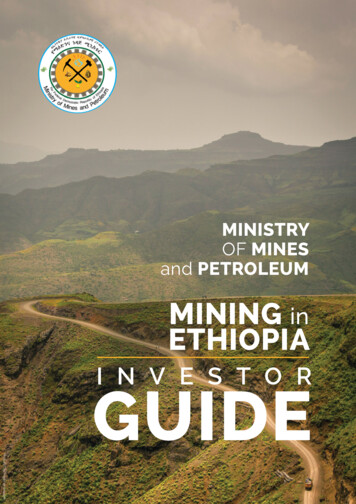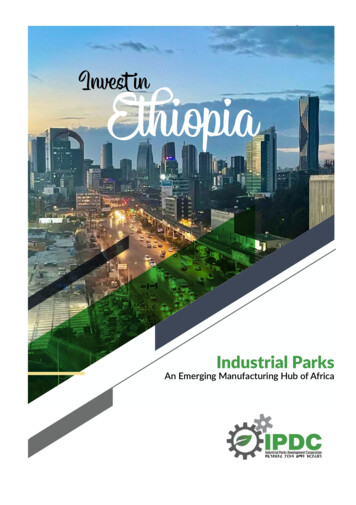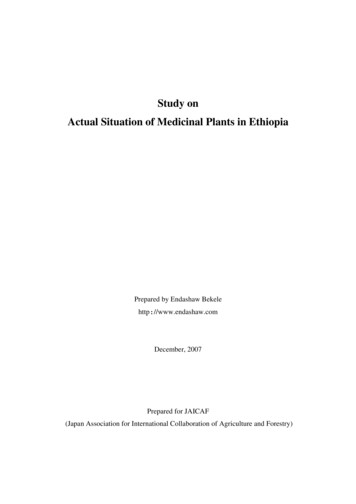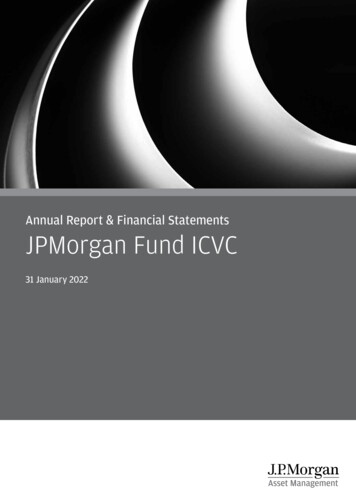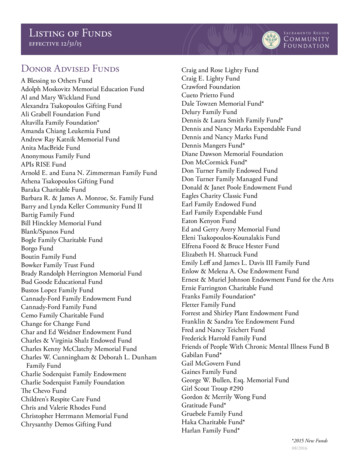
Transcription
CLEAN TECHNOLOGY FUNDEthiopia: Tulu Moyo Geothermal Power ProjectUSD 10 millionMarch 2020
TABLE OF CONTENTSCOVER PAGE31.INTRODUCTION62.PROJECT DESCRIPTION63.CTF INVESTMENT CRITERIA114.MONITORING & EVALUATION125.CONCLUSIONS13ANNEX I: CTF INVESTMENT CRITERIA CALCULATIONS14ANNEX II: RISKS AND MITIGANTS15
Cover PageCTF Project/Program Approval RequestDedicated Private Sector Programs (DPSP-III)2.Ethiopia1.Country/Region3.Public or Private4.Project/Program Title5.Is this a private sector programcomposed of sub-projects?CIF ProjectID#[CIF AU willassign ID]PublicPrivateXYesNoXTulu Moyo Geothermal Power ProjectFinancial Products, Terms and AmountsFinancial ProductGrantFee on grantMPIS (for private sector only)6.Public sector loanUSD(million)0.000.000.00Harder termsSofter termsEUR(million)0.000.00Senior loanSenior loans in local currency hedgedSubordinated debt / mezzanine instruments with incomeSecondloss rdinated debt/mezzanine instruments with convertibleConvertiblefeatures grants and contingent recovery grantsContingent recovery loansFirst loss guarantees0.000.000.000.000.00Other (please specify)0.00TotalAfDBImplementing MDB(s)NA8. National Implementing AgencyLeandro Azevedo (l.azevedo@afdb.org)9. MDB Focal Point10. Brief Description of Project/Program (including objectives and expected outcomes)[c]7.[Note: This project was not part of the latest DPSP III pipeline submitted to the CTF TFC. The inclusion of theproject in the pipeline follows a review exercise undertaken by MDBs and the CIF AU in early 2020. It was agreedthat the CTF TFC would be informed of the pipeline update at the time of submission of this proposal.]The Project involves the design, construction, commissioning and operation of a 50 MW geothermal power plant undera Build, Own, Operate and Transfer (BOOT) project financing structure. The Project is the first phase of the cumulativegeneration capacity of 150MW being targeted by the Government of Ethiopia (GoE) which is expected to be completedby 2024. The project is located about 100 km Southeast of Addis Ababa in the Oromia Regional State covering a 588 sq.km concession area with an estimated potential of 2 GW. The Project includes a sub-station and an 11 km transmissionline to connect to an existing 132KV line for transfer to Ethiopia Electricity Power (EEP). Half of the costs associated3
with the connection to the grid of the power plant will be reimbursed by EEP. The total avoided greenhouse gas emissionis estimated at 10,512,000 t CO2 eq. over the project lifetime. The project will lead to the creation of 600 jobs.11. Consistency with CTF investment criteriaSee page 11(1) Potential GHG emissions savingsSee page 11(2) Cost-effectivenessSee page 11(3) Demonstration potential at scaleSee page 11(4) Development impactSee page 11(5) Implementation potentialSee page 12(6) Additional costs and risk premiumAdditional CTF investment criteria for private sector projects/ programsSee page 12(7) Financial sustainability(8) Effective utilization of concessional See page 12(includinga detailedSee page 12(9) financeMitigationof marketdistortionsanalysis on how the proposal meetsSee Annex II.(10) Riskstheminimumconcessionality12. For DPSP projects/programs in non-CTF countries, explain consistency with FIP, PPCR, orprinciples,and on howit is alignedSREPInvestmentCriteriaand/or national energy policy and strategywiththeblendedconcessionalThe Ethiopia SREP Investment Plan that was endorsed by the SREP Sub-Committee on March 2012 highlighted thefinanceofprinciples)importanceconsidering renewable energy technologies other than hydro to reduce the country’s exposure to thenegative impacts that severe droughts have on its hydro generation assets. Furthermore, Ethiopia’s Climate ResilientGreen Economy Strategy explicitly focuses on addressing issues of energy access, quality of supply and productiveenergy use, particularly for rural communities.The proposed facility will contribute to accelerate the electrification targets embedded in Ethiopia’s NationalElectrification Plan (NEP) 2.0 launched in March 2019.13. Stakeholder EngagementTulu Moye Geothermal Company (TMGO) – the project Special Purpose Vehicle - has undertaken several Stakeholderconsultation and sensitization workshops on the project targeting respective stakeholders (i.eg Government officials,financiers, district & municipal authorities and residents of the concerned communities). In particular, the ProjectCompany stakeholder engagement plan encompasses key elements notably with regards to stakeholder mapping,engagement strategies, awareness creation among vulnerable groups, grievance redress mechanisms for affectedcommunities and disclosure of relevant project information.14. Gender ConsiderationsEthiopia’s National Policy on Women formulated in 1993 aimed at creating appropriate structures within governmentoffices and institutions to establish equitable and gender-sensitive public policies. Within the Ministry of Energy, thewomen and Youth Affairs Directorate is responsible for monitoring, facilitating and designing ways for smoothimplementation of the aforementioned policy in the energy sector.Women are active participants in the social, political and cultural activities of their communities and therefore economicdevelopment in Ethiopia is unthinkable without the participation of women. That said, gaps between men and women areespecially prevalent in infrastructure sectors such as energy, where the roles of women and girls in the household, marketand community can affect their ability to access, control and use electricity services. Ethiopia has set a 2025 target ofuniversal electricity access, as well as 100% access for primary and secondary schools, hospitals, and primary healthcenters.The GoE is not only looking at electricity access rates and utility gender balance, but also at gaps between men andwomen in access to finance to purchase solar panels and other renewable energy technologies. These commitments arewell captured in the National Electrification Program (NEP) launched in 2017 and in the new engagement areas targetedin NEP 2.0 launched in March 2019.The proposed project will play a positive role towards improving the climate resilience of the country’s on-grid generationassets which will in turn lead to improvements in the resilience of the Ethiopian people due to an increase in access to anaffordable and productive source of electricity.4
15. For projects/programs with activities in countries assessed as being at moderate or high risk ofdebt distress, macro-economic analysis to evaluate the potential for the CTF project or program toimpact the country’s debt sustainabilityAs of end 2018, Ethiopia’s Debt Sustainability Distress rating was “high”. Despite sustained high economic growth overthe last decade (9% between 2018-2019 positioning Ethiopia was one of the World’s 10 fastest growing economies),substantial progress on reducing poverty and improving social indicators, policies appropriately targeted at containingpublic investment and debt that contributed to narrowing the current account deficit to 4.5% of GDP and a reduction inpublic and publicly-guaranteed debt to 57% GDP (of which half is held local lenders), the country has work to do in orderto reduce its risk of debt distress. The Government of Ethiopia has taken proactive steps, including initiation ofdiscussions with bilateral creditors to seek additional relief on debt servicing and tightening control over externalborrowing by public enterprises. These together with other measures led to a welcoming slowdown in Ethiopia’s externaldebt accumulation positioning Ethiopia’s external debt to GDP ratio (31.4%) below the average for low-income countries(40%). The ongoing IMF program in Ethiopia aims to reduce the country’s risk of debt distress rating, as defined in theWorld Bank-IMF Debt Sustainability Analysis, to “moderate” before the end of the program in 2023.The CTF loan will be extended to a private entity meaning that this amount will not account to the sovereign debt of thecountry. However, the Government of Ethiopia will be providing a sovereign guarantee to cover the payment default bythe off-taker. AfDB is still in discussions with Ethiopia to provide a partial credit guarantee to cover part of this risk.Given the size of the project, it is unlikely that the envisaged sovereign guarantee will cause a substantial impact on thesuccessful implementation of the IMF program.16. For public sector projects/programs, analysis of how the project/program facilitates private sectorinvestmentNot applicable.17. Indicators and TargetsProject/Program TimelineExpected start date of implementationExpected end date of implementationExpected investment lifetime in years (for estimating lifetime targets)Core IndicatorsGHG emissions reduced or avoided over lifetime (tons of CO2-eq)Annual GHG emissions reduced or avoided (tons of CO2-eq/year):Installed Capacity of Renewable Energy (MW)June 2021June 203918Targets10,512,000420,48050Annual Additional Power Generation Capacity (in MWh)413.250Identify relevant development impact indicator(s)TargetsJobs Created during ConstructionJobs Created during Operations)5505018. Co-financingPlease specify as appropriateAfDBOther DFIsGRMFUSTDAPrivate SectorPrivate SectorSenior LoanSenior LoanGrantGrantLoanEquityTotal19. Expected Date of MDB Approval30 November 20205Amount(in million USD)82.50105.491.3010.7011.9727.94239.9
1.INTRODUCTION1.1With a population of over 105 million, Ethiopia is the second most populous country in Africa. Economicgrowth in Ethiopia has recently been among the highest in the world, with the compound annual GDP growth rateexceeding 10% between 2006 and 2016. Though slightly lower than in recent years, the country still experienced anestimated growth rate of 7.9% (2018) and 9.0% (2019)1. Much of the recent growth has been driven by publicexpenditures and infrastructure investments. Private consumption and domestic demand are projected to grow at asteady pace in the next five years.1.2Of the Ethiopian total population, 80% live in rural areas and over 70% of the work in the agricultural sector.According to the National Bank of Ethiopia (NBE), agriculture and services contributed 33.78% and 36.64%respectively to the Gross Domestic Product (GDP) in fiscal year 2017. The following year, the agricultural sector’sshare of GDP moderately decreased 31.19%, while the service sector’s slightly dropped by 36.52%. These economicshifts supported by strong industrialization policy, highlight ongoing and impending urbanization in the comingdecades, which will necessitate significant investments into adequate infrastructure, particularly in energy.1.3The country has more than doubled its generation capacity from 2,000MW in 2011 to 4,284MW in 2018consisting of: (i) hydro (3,816MW - 89%), (ii) wind (324MW - 7.5%), (iii) diesel generators (97MW - 2.2%), (iv)biomass (40MW - 0.9%), and (v) geothermal (7.3MW - 0.17%). Ethiopia enjoys high geothermal potential with anestimated capacity of 5,000 – 7,000MW with resources being scattered in the Rift Valley and in the Afar depressionwhich are both part of the Great East African Rift System.1.4Under the Growth and Transformation Plan (GTP II), which aims to transform Ethiopia into an industrializedmiddle-income country by 2025, the national power generation capacity is expected to exceed 14,000 MW by 2025.1.5The Tulu Moye 50MW Geothermal project was selected for the concession area before the enactment of thePublic-Private Partnership Proclamation Law established in 2017. The effectiveness of the project’s ImplementationAgreement (IA) will require; (i) amendment of the Geothermal Resources Development Proclamation; (ii) RatificationEffectiveness Protocol to be signed by the Council of Ministers, and (iii) issuance of a Legal Opinion on the RatificationEffectiveness Protocol by the Legal Director of the Ministry of Finance.1.6The Dedicated Private Sector Program (DPSP), established under the Clean Technology Fund (CTF) in 2013,was designed to finance programs or projects that can deliver scale in terms of development results and impact, supportprivate sector and fast-track the deployment of CTF resources under more efficient processing procedures whilemaintaining a strong link to country priorities as well as CTF program objectives. This funding request is beingsubmitted as part of DPSP III.2.PROJECT DESCRIPTION2.4The project involves the design, construction, commissioning and operation of a 50 MW geothermal powerplant under a Build, Own, Operate and Transfer (BOOT) project financing structure. The project is the first phase ofthe cumulative generation capacity of 150MW being targeted by the Government of Ethiopia (GoE) which is expectedto be completed by 2024. The project is located about 100 km Southeast of Addis Ababa in the Oromia Regional Statecovering a 588 km2 concession area with an estimated potential of 2 GW. The project will include a sub-station and an11 km transmission line to connect to an existing 132KV transmission line. Half of the costs associated with theconnection to the grid of the power plant will be reimbursed by the Ethiopia Electricity Power (EEP).1"Global Economic Prospects, January 2020 : Slow Growth, Policy Challenges" , World Bank, Jan 20206
2.5The project’s initial planning and preparation stages commenced in 2014 and the sponsor has made significantprogress since then. In November 2015, the sponsor obtained a USD 1.3 million grant from the Geothermal RiskMitigation Facility (GRMF) to conduct surface studies. The work was successfully completed in Q2 2016. Additionalgrant funding of USD 10 million has been secured from USTDA.Figure 1: Project Area2.6To verify the geoscience studies conducted on the field since 2015, three wells will be drilled from two wellpads aimed at confirming the geothermal resource potential. Three exploration wells will be drilled as full-sizeproduction wells. For Phase 1, eight production wells are likely to be required (including the three exploration wells)and one additional well for re-injection. Four well pads have already been identified for exploration and productionwells and one for the injection well. In October 2019, the sponsor signed a drilling contract with KenGen, anexperienced Kenyan power generation company with more than 530MW of geothermal power generation in itsportfolio. Drilling started in February 2020 with well test results expected in May 2020.The Sponsor2.7The Tulu Moye Geothermal Operations Private Limited Company (TMGO) – the special purpose vehicle forthe project - was incorporated in Ethiopia. TMGO is 100% owned by Tulu Moye SAS, a company registered in Franceand 51% owned by Meridiam Infrastructure Africa Fund and 49% by Reykjavik Geothermal (RG). Meridiam wasestablished in 2005 and is a global developer, investor and asset manager specializing in public and communityinfrastructure delivered through Public-Private Partnership (PPP) schemes with EUR 6.2 billion currently undermanagement through 7 funds operating in the United States, Europe and Africa.2.8RG was founded in 2008 by a well experienced geothermal management and science teams. RG’s foundersand staff have been involved with the development of numerous geothermal projects in Iceland. RG has been workingin Ethiopia since 2010 and secured the rights (licenses, etc.) to develop geothermal power for sale to EEP across 3 sites:(i) Tulu Moye (500MW), (ii) Corbetti (500MW), and (iii) Abaya (300MW).7
Cost Structure and Financing Plan2.9The project’s total costs are estimated at USD 249.9 million as per Table 1 below.Table 1: Sources and Uses of Funds (in USD million)SOURCES OF FUNDSDescriptionAmountAfDB Senior Loan82.50Other DFIs Loans2105.49GRMF Grant1.30USTDA Grant10.70CTF Concessional Loan10.00%33.0142.210.524.284.00EquityShareholders Loans11.9727.94249.90TOTAL4.7911.18USES OF FUNDSDescriptionAmountProject Development33.60Drilling61.40EPC90.60Owner’s Contingency7.33Financing Costs37.50Pre-funded Working Capital0.47Debt Service Reserve Account7.04VAT on 0.0TOTAL100.0249.902.10The Engineering, Procurement and Construction (EPC) contract and the Drilling contract are the mostimportant cost items representing 36% and 25% of the total costs respectively. Three exploration wells, five productionwells and one reinjection well are anticipated for a total USD 61.4 million. The average cost of drilling each well isexpected to be USD 6.8 million. A construction contingency (Owner’s Contingency) of USD 7.33 million is beingincluded as a cost component.2.11The Project Development costs include up-front borne to secure rights to the project, project management feesup to financial close and a sponsors’ development fee. These fees will be subject to audit during due diligence of theproject. The pre-funded working capital included is a permanent cash buffer that will be required during the life of theproject.2.12Financing Costs includes lender due diligence costs, interest during construction, and facility fees charged bythe senior lenders. Value-Added Tax (VAT) will be charged at a rate of 15% over all construction expenditures butshould be recoverable within 6 months from the beginning of construction.2.13The total investment proposed by the shareholders amounts to USD 39.9 million. AfDB in cooperation withother prospective lenders may request shareholders to increase their participation depending on the credit risk associatedwith the project.AfDB’s Role2.14AfDB is considering a senior loan of up to USD 82.5 million with a tenor of 18 years including a grace periodof 38 months.Implementation Arrangements2.15Project Site: The site is located in the Ethiopian Rift Valley in northern part of the East African Rift system, anarea characterized by active extensional tectonics and associated volcanic activity. The site is located about 100 kmsoutheast of Addis Ababa in the Oromia Regional State. TMGO has completed comprehensive geothermal site studieswhich estimate the geothermal potential at around 2GW. TMGO is responsible for acquiring and maintaining the landas well as to secure rights of way required for the successful implementation of the project. Under the IA, the GoEagreed to: (i) grant the land rights required over the land it owns at the site, and (ii) acquire rights over any additionalland required by the project.2Discussions are ongoing with FMO, DEG, Proparco, EIB and OPIC.8
2.16EPC and O&M: KenGen has been contracted to drill the steam wells. An EPC contract will be engaged todesign and install the steam gathering system, the power plant and the power evacuation system. The major constructionwork packages expected for the Project are: (i) preparatory works (bulk earthworks, drainage), (ii) steam fielddevelopment supply, piping and reinjection system, (iii) power plant, and (iv) transmission line and switchyard. TMGOwill recruit an O&M company prior to financial close. Both AfDB and the Lenders’ Technical Advisors will undertakedetailed due diligence on the proposed companies to ensure they have the technical requirement and track record todeliver without compromising the success of the project.2.17Power Purchase Agreement: A 25 year take-or-pay Power Purchase Agreement (PPA) was signed betweenTMGO and EEP in December 2017. The tariff is USD 6.95 cents/kwh equivalent in Ethiopian Birr subject to anexchange rate reconciliation mechanism that will be detailed as a Condition Precedent to the effectiveness of the PPA.This mechanism will be further reassessed to ensure that AfDB, other senior lenders and CTF are not exposed tocurrency exchange risk. The annual rate of tariff escalation is 2.4% for years 1-5 dropping gradually thereafter to 2.0%at year 20 and beyond.2.18Government Support: In December 2017, the Project Company signed an IA with the GoE. Under the terms ofthis agreement, TMGO will benefit during full duration of the PPA of the following: (i) full rights to develop andoperate the project, (ii) certain tax exemptions and tax incentives, (iii) a government guarantee in relation to the ongoingpayment obligations of EEP under the PPA, and (iv) rights to convert local currency into USD and to repatriate theproceeds.2.19Grid Integration: TMGO is currently in discussion with EEP with regards to the proposed evacuation route.EEP have completed the draft grid study report which states that an evacuation voltage of 230 kV and an 11kmtransmission line are required. The grid study considered several connection options for each of the four phases of theproject.2.15Environmental and Social Safeguards: The proposed project is classified as category I in line with AfDB’sIntegrated Safeguards System. This means TMGO will provide an Environmental and Social Impact Assessment(ESIA), an Environment and Social Management Plan (ESMP) to be reviewed prior to the approval of any financing.Summaries of these documents shall be made publicly available 60 days prior to approval by AfDB’s Board ofDirectors. During supervision, AfDB’s safeguards teams will make sure the sponsor is continuously monitoring allpotential risks identified in the ESMP and that all proposed mitigation measures are being implemented.2.20Implementation Schedule: Construction schedule is estimated to last for a period of 36 months. Theconstruction phase will consist of: (i) steam gathering system, and (ii) the power generation facility.2.21TMGO contracted KenGen, a leading electrical power generating company in Kenya, East Africa to undertakeall exploration drilling activities. KenGen mobilized the drilling rig in January 2020 and started the drilling of threeexploration wells on two well pads. These activities are expected to be finalized by November 2020. Securing adequatesteam supply to meet the needs of the power plant is the major risk for a geothermal project. In the context of thisparticular project, this risk will be fully allocated to TMGO as these costs will be fully funded by their own financialcontribution to the project and by proceeds of the USTDA grant. All senior lenders, including the CTF, will benefitfrom the Lenders Technical Advisor’s confirmation that adequate steam is available to meet the envisaged 50MWcapacity of the power plant.The Market2.22Institutional and Regulatory Environment. In 2013/4, the GoE ratified several new regulations andproclamations which, among others, divided EEPCO into two separate entities, the Ethiopian Electric Power (EEP) andthe Ethiopian Electric Utility (EEU). The EEP was established by Council of Ministers Regulation No. 302/2013 and9
assumed responsibility for generation and transmission, leasing of transmission lines and sale of bulk power. EEP isresponsible for the purchase of wholesale power from Independent Power Producers (IPPs) and the supply of electricityto EEU as well as several neighboring countries. The Ethiopian Energy Authority (EEA) is the state regulator and fallsunder the direct responsibility of the Ministry of Water Irrigation and Electricity (MoWIE). The EEA issues investmentpermits pursuant to the Investment Proclamation No. 769/2012. It also issues generation licenses of 25-years forhydropower and geothermal technologies and 20-years for wind, solar and biomass. Currently, no law addresses energytariffs aside from Proclamation No.810/2012, which grants the EEA sole authority to determine tariffs.2.23Electricity Demand. Ethiopia continues to register high economic growth over the past decade, with annualaverage real GDP growth rate of 10.8% since 2004/05. Public sector investments in infrastructure has underpinned thisstrong economic growth. Since 2010, the demand for electricity is growing at an annual average rate of 15%. This isdriven by a sustained increase in industrialization and by a renewed focus on the increase of energy access. In 2014,EEP projected electricity sales to grow from 4,925 GWh in 2012 to 97,326GWh by 2037 for a compounded annualgrowth rate of 12.7%. GoE has prioritized the development of industrial parks and export-processing zones and hasenacted policies to encourage foreign direct investment and private investment into various sectors of the Ethiopianeconomy. This industrialization strategy of GoE is expected to further drive the demand for electricity.2.24Electricity Supply. Ethiopia has a generation capacity of 4,284MW of which 89% is hydro based. To supplythe energy needs of a growing population, the GoE is focusing on the nation’s abundant natural resources to meet itsgeneration targets. The 6,000MW Grand Ethiopian Renaissance Dam (GERD) will play a large part in achieving thecountry’s goal. However, the project is far behind schedule and IPPs will be critical for the country to achieve its targetcapacity. Ethiopia has high geothermal potential with an estimated capacity between 5,000–7,000MW havingprioritized the development of up to four geothermal projects with a combined capacity of 1,270 MW over the nextfive years. Investments to exploit these resources and transition to a more diversified energy mix are in line withEthiopia’s Nationally Determined Contribution (NDC) under the Paris Agreement and the SREP Investment Plan. TheGoE is aware of the important of reducing the sector’s dependence on hydropower as droughts continue to severelyaffect the sustainability of power supply leading often to load shedding.2.25Since January 2018, reform of the power sector has commenced with the enactment of the PPP ProclamationLaw, revision of the tariff regime, signing of PPAs for the first two IPPs (Geothermal) and decentralization of powerdistribution to nine regions within the country. Transmission and distribution (last mile connectivity) are targeting upto 4.5 million new household grid connections by 2025 based on an annual connection rate of 1 million households peryear. The off-grid program of the country targets up to 5.7 million new household connections by 2025.2.26Competition. The GoE is promoting the participation of private sector in power generation. A good example,is the plan to develop up to 250MW of solar PV as part of IFC’s Scaling Solar initiative. Other development partnersare also supporting the diversification of the energy mix with USAID supporting the Metehara 100 MW Solar PVproject, the 100 MW Mekele Solar PV project, the 100MW Humera Solar PV project and the Corbetti 500 MWgeothermal project.2.27Opportunity. The GoE estimates demand to reach 64.2TWh in 2030, mainly driven by the commercial,industrial and agricultural users. Ethiopia’s annual energy consumption per capita (around 120kWh) is still lower whencompared to countries such as India (806kWh), Vietnam (1,411kWh), and China (3,927kWh). Economic growthleading to an increase in per capita energy consumption will require further investment in energy infrastructure in themedium term. Recently completed and ongoing investments in power transmission interconnections to neighboringcountries will enable exports to Djibouti, Sudan, Kenya, Tanzania, Uganda, and Rwanda. While power trade in the EastAfrica Power Pool region is based on bilateral agreements between countries, there are plans for the development of atrading platform which could enable not only regional integration gains but also a more competitive power trade in themedium to long-term in a bid to optimize the energy systems of participating countries. Based on GoE’s estimates, thecountry could export nearly 1,000MW of power by 2025 and thereby generate more than USD 500 million per year inrevenues.10
3.CTF INVESTMENT CRITERIAPotential GHG Emission Savings3.4With CTF funds of USD 10 million, the project will leverage an additional USD 239.9 million in equity anddebt from other investors. This provides a leverage ratio of roughly 1 to 23.99. Emission reductions for the project areexpected to equal 420,480 tCO2 eq. per year. Assuming a life of 25 years for the infrastructure, the project willcontribute to a total reduction of 10,512,000 tCO2 eq. over the life of the power plant.Cost Effectiveness3.5With CTF funds of USD 10 million and estimated total emission reductions of 10,512,000 tCO2 eq. over thelife of the infrastructure, the cost effectiveness of CTF funds is roughly USD 0.95 per tCO2 eq. More detailedcalculations can be found in Annex I.Demonstration Potential at Scale3.6As one of the first IPP projects in Ethiopia, the project will have positive demonstration effects for other privatesector players entering the energy market in Ethiopia. This is especially important given the need of the GoE to lowerthe burden on its sovereign debt levels while meeting their development plans for the sector. As a front runner IPP, thesuccessful implementation of the project will also test the ongoing sector reform process and establish Ethiopia as asound investment destination. The project will also contribute to the establishment of a domestic geothermal sector inEthiopia that could in the future generate various employment opportunities and to contribute to economic growth.Development Impact3.7The project will benefit the local economy through direct job creation and upskilling of the local workforce aswell as generation of additional electricity for the country including diversification from hydropower which dominatespower generation in Ethiopia and is subject to great seasonal variation due to droughts. Approximately 550 workerswill be required during the construction phase and approximately 50 during operations. Additionally, there arepossibilities to engage local small and medium enterprises in Oromia Regional State with procurement opportunitiesduring the various phases of project implementation3.8Once operational, the project will generate a total of 413,250 MWh per year. Based on a per capita averageelectricity consumption of 83 kWh, the power generated by the proposed
Green Economy Strategy explicitly focuses on addressing issues of energy access, quality of supply and productive energy use, particularly for rural communities. The proposed facility will contribute to accelerate the electrification targets embedded in Ethiopia's National Electrification Plan (NEP) 2.0 launched in March 2019. 13.
